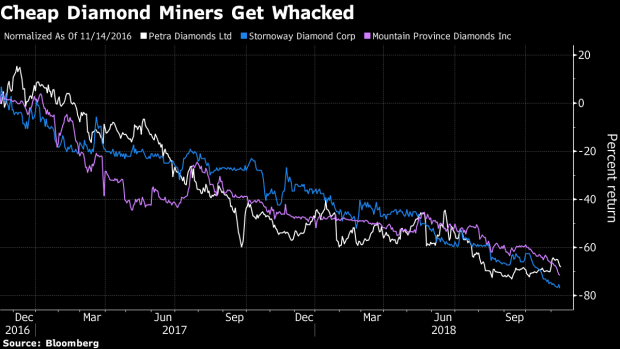Nov 13, 2018
De Beers Price Cuts Show It's Hard Times for Ugliest Diamonds
, Bloomberg News

(Bloomberg) -- De Beers has been forced to make big cuts in what it asks customers to pay for the worst diamonds it sells. It’s the latest sign the industry’s cheapest goods are increasingly unloved.
The industry produces about 15,000 different categories of diamonds, ranging from giant flawless gems that sell for millions of dollars to fragments worth just a handful. In the past few years, those at the bottom end have been having a tough time.
The biggest headache is there’s just too many lower quality stones.
While no new major diamond mines were built between 2003 and 2012, recently a spate of new projects started in Lesotho, Canada and Russia. Those ventures have compounded the problem by producing more than the industry average of low-value stones.
Existing producers have also been increasing output. Rio Tinto Group’s Argyle operation in Australia produces a greater volume of diamonds than any other mine, but they sell for just $15 a carat. That’s less than a 10th of average price realized by De Beers. The Anglo American Plc unit is also producing more stones than at any time since the global financial crisis and a lot of the new output is lower quality.
The weak performance of those stones is likely to continue until Argyle closes in 2021, according to Berenberg analyst Richard Hatch.
There are other problems too. Indian Prime Minister Narendra Modi’s fight against so-called black money in 2016 caused producers such as De Beers to hold back supply, which has now been sold back into the market.
A weaker rupee is also making diamonds more expensive, cutting demand in a market that buys a lot of lower-end goods. A major bank fraud in India earlier this year saw further cuts to diamond trade finance, making purchases more difficult for some buyers.
While almost all diamond mines produce a variety of stones, some are more exposed to the low quality end of the market. Stornoway Diamond Corp., Petra Diamonds Ltd. and Mountain Province Diamonds Inc. have all lost more than two thirds of their value in the past two years.
To contact the reporter on this story: Thomas Biesheuvel in London at tbiesheuvel@bloomberg.net
To contact the editors responsible for this story: Lynn Thomasson at lthomasson@bloomberg.net, Dylan Griffiths, Nicholas Larkin
©2018 Bloomberg L.P.


